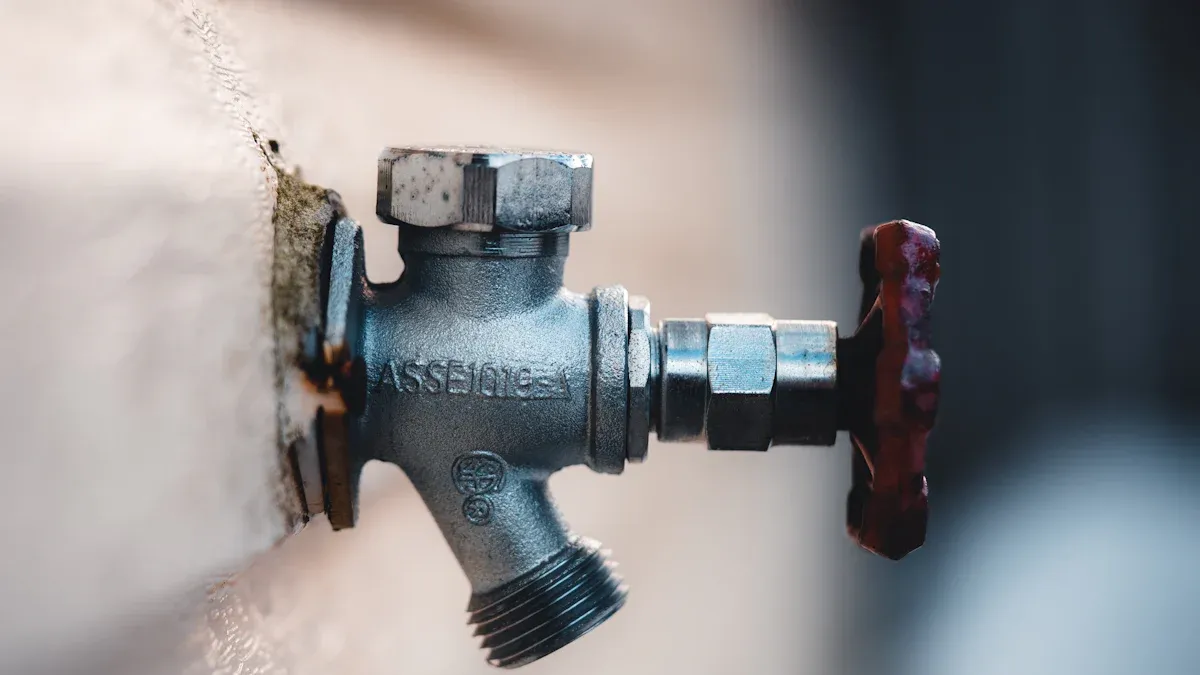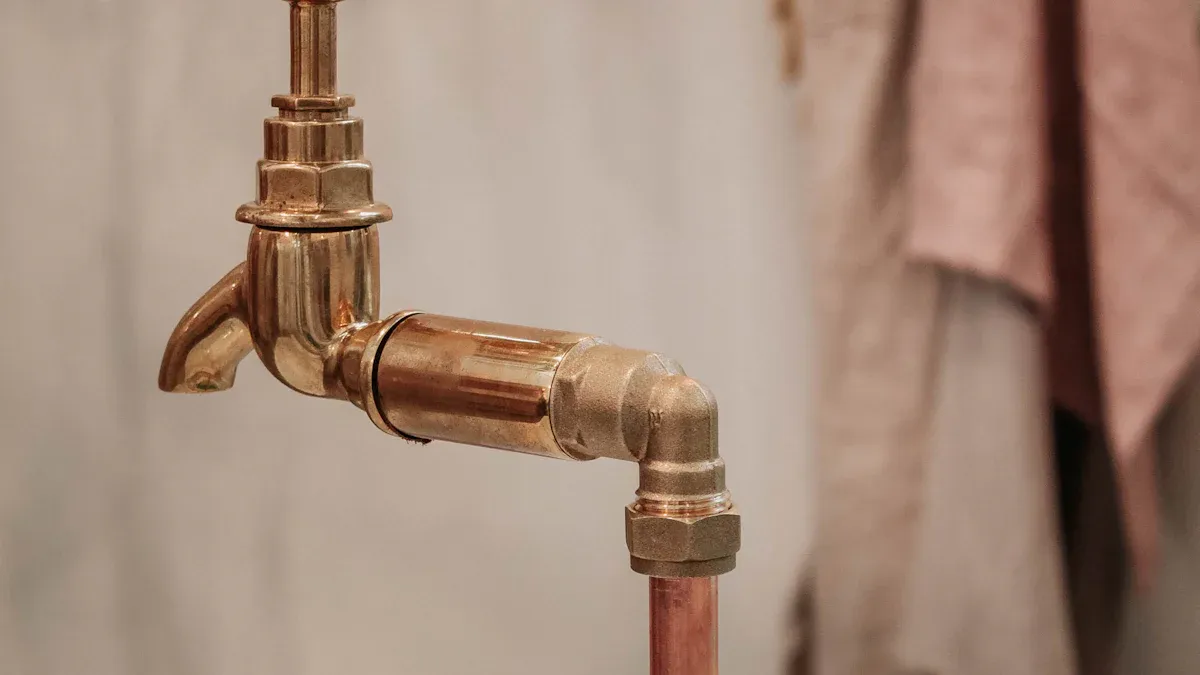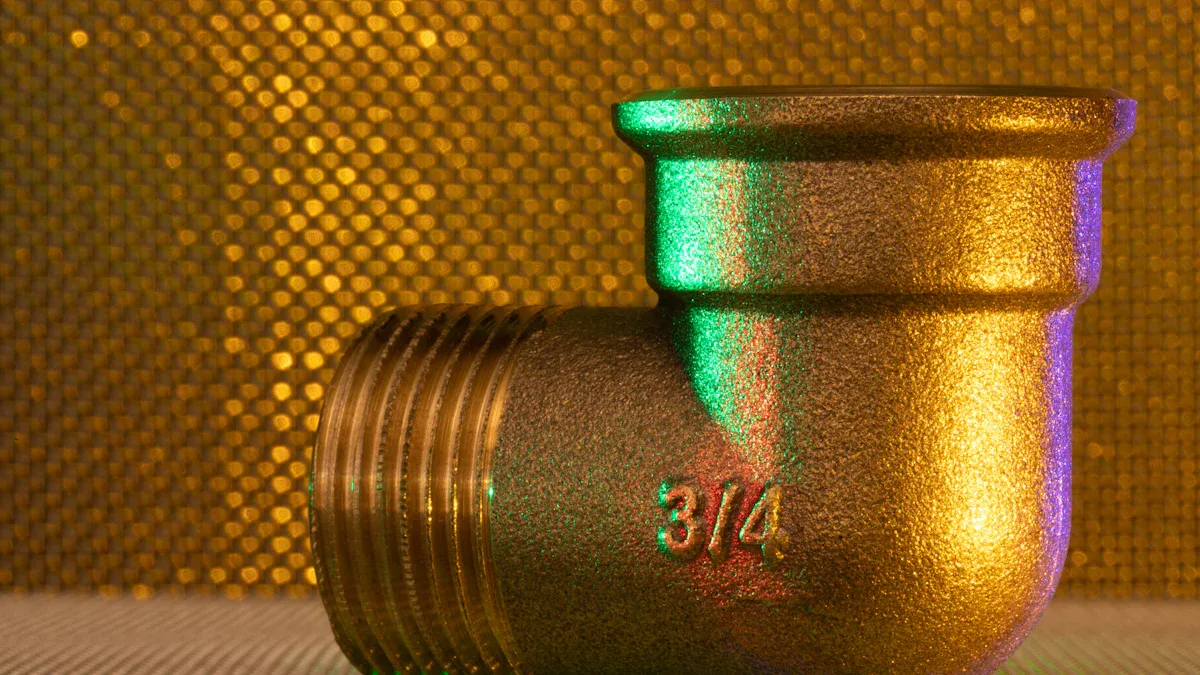
Selecting the right brass fittings is crucial for optimal plumbing performance. High-quality brass fittings enhance the longevity of plumbing systems, often lasting between 80 to 100 years. However, plumbers face challenges such as mismatched sizes, ignoring pressure ratings, and selecting low-quality fittings, which can compromise system integrity.
Key Takeaways
- Choosing high-quality brass fittings enhances the durability and longevity of plumbing systems, often lasting between 80 to 100 years.
- Consider the size and compatibility of brass fittings with existing plumbing to ensure optimal water flow and pressure.
- Consulting with plumbing professionals can help avoid common mistakes and ensure compliance with safety standards.
Overview of Brass Fittings

Definition and Purpose
Brass fittings play a vital role in plumbing systems. They serve as connectors for pipes, faucets, and various fixtures. Their primary functions include:
- Connecting pipes made from different materials, such as copper, steel, and PVC.
- Ensuring a secure and leak-free connection in both residential and commercial plumbing systems.
- Providing resistance to corrosion, which is essential for both hot and cold water supply systems.
Brass fittings are known for their durability and reliability. They outperform many other materials in terms of corrosion resistance, making them a preferred choice for plumbing applications.
Common Applications
Brass fittings find extensive use in various plumbing scenarios. Here are some of the most frequent applications:
| Type of Brass Fitting | Application Description |
|---|---|
| Brass Tap Connectors | Used in home plumbing systems for durability and resistance to temperature variations. |
| Brass Pipe Connectors | Common in industrial applications for superior strength and electrical conductivity. |
| Brass Quick Connectors | Favored in pneumatic and hydraulic systems for quick and easy connections. |
| Brass Press Fittings | Ideal for residential, commercial, and industrial applications due to flame-free joining. |
| Used for Water, Heating, Gas | Provides permanent, watertight seals, reducing human error and installation time. |
These applications highlight the versatility and effectiveness of brass fittings in modern plumbing installations. Their ability to connect various pipe types while maintaining strength and durability makes them indispensable in both residential and commercial settings.
Types of Brass Fittings

Compression Fittings
Compression fittings are popular for their versatility and ease of use. They connect pipes by tightening a nut, which compresses a sleeve against the pipe. This method creates a secure seal without the need for soldering or welding.
Advantages of Compression Fittings:
- Flexibility allows for disassembly and reassembly.
- Suitable for various pipe materials, including copper and plastic.
| Feature | Brass Compression Fittings | Brass Press Fittings |
|---|---|---|
| Installation Process | Tightening a nut compresses a sleeve against the pipe | Using a pressing tool to create a permanent joint |
| Advantages | Flexibility and ease of disassembly | Quick installation and leak-free connections |
| Applications | Suitable for various pipe materials | Primarily for secure, leak-free connections |
Solder Fittings
Solder fittings provide a strong, permanent bond, making them ideal for high-pressure applications. They require a heat source to melt solder, which joins the pipes.
| Advantages | Disadvantages |
|---|---|
| Provides a strong, permanent bond. | Requires a heat source, which can be dangerous. |
| Soldered joints are generally more durable. | Time-consuming compared to compression fittings. |
| Works well for high-pressure applications. | Requires more skill and experience for a good seal. |
Threaded Fittings
Threaded fittings utilize tapered threads to create a strong, leak-proof seal. They perform exceptionally well under high-pressure conditions. Most residential brass fittings can handle up to 200 PSI, while industrial-grade fittings can manage even higher pressures. Proper selection ensures safety and performance.
- Brass fittings resist sudden spikes in pressure.
- High tensile strength prevents cracking and deformation.
Push-Fit Fittings
Push-fit fittings offer a quick and easy installation process. They require minimal tools and no soldering. To install, one must cut the pipe, deburr the edges, and insert it into the fitting until it reaches the marked depth.
-
Necessary Tools:
- Marker
- Push-fit fitting
- Tubing cutter
- Utility knife (if needed)
- Emery cloth (if required)
- Deburring tool (to measure the depth)
-
Cutting the Pipe:
- Cut the required length of the pipe, allowing an extra inch for insertion.
-
Reaming and Deburring the Pipe:
- Clean and smooth the pipe’s edges using a deburring tool and emery cloth.
-
Marking the Pipe:
- Use a marker to indicate the depth for proper insertion into the fitting.
-
Installing the Fitting:
- Insert the pipe into the fitting until it reaches the marked point, then rotate to secure.
These various types of brass fittings cater to different plumbing needs, ensuring that professionals can select the right option for their specific applications. Choosing high-quality brass fittings enhances the overall performance and longevity of plumbing systems.
Key Factors to Consider
Size and Dimensions
Choosing the correct size and dimensions for brass fittings is essential for optimal plumbing performance. The size of the pipes directly influences water flow and pressure. A smaller diameter pipe increases resistance, reducing flow and raising pressure. Conversely, larger pipes can lead to slow water movement, negatively affecting system efficiency.
| Size | Application Type |
|---|---|
| 1/4" | Residential |
| 3/8" | Residential |
| 1/2" | Residential |
| 3/4" | Residential |
| Larger | Commercial/Industrial |
Selecting the right size ensures effective water delivery and pressure maintenance, which is crucial for any plumbing system.
Specifications and Standards
Compliance with specifications and standards is vital for ensuring the safety and reliability of brass fittings. Manufacturers must adhere to international regulations regarding product safety, material composition, and manufacturing processes. Key standards include:
- NSF/ANSI/CAN 61: Ensures that brass fittings do not leach harmful substances into potable water.
- ISO 9001 and ISO 14001: Implemented for quality management and environmental responsibility.
- Lead-free initiatives: Comply with regulations like the Reduction of Lead in Drinking Water Act.
These standards provide confidence in the performance and safety of brass fittings, making them suitable for various applications.
Quality and Material Grade
The quality of brass fittings significantly influences their longevity and performance. Commonly used brass grades include:
| Brass Grade | Composition (Copper, Lead, Iron) | Key Properties |
|---|---|---|
| CW617 Brass | 57-60% Copper, 2.4-3.7% Lead, 0.5-1.9% Iron | Excellent corrosion resistance, high ductility, low dezincification resistance |
| 58-3 Brass | 63-68% Copper, 0.07-0.12% Lead, 0.03-0.06% Iron | Good corrosion resistance, high strength, excellent brazing properties |
High-quality brass fittings are low maintenance due to their corrosion-resistant properties. Regular inspections can help identify potential issues, extending the life of the fittings and preventing costly repairs.
Compatibility with Existing Systems
When integrating brass fittings with existing plumbing systems, compatibility is crucial. Brass fittings can suffer from accelerated corrosion when mixed with stainless steel due to galvanic corrosion. Additionally, chemical interactions with fluids, especially those containing chlorides or acids, can compromise the protective layers on brass.
To ensure compatibility, consider the following steps:
- Clean the threads of both male and female fittings using a brush and solvent.
- Inspect for damage and ensure surfaces are dry and free of contaminants before applying sealant.
- Choose the appropriate thread sealant based on system requirements and environmental conditions.
These precautions help maintain the integrity of the plumbing system.
Choosing High-Quality Brass Fittings
Identifying high-quality brass fittings in the marketplace requires careful consideration. Key criteria include:
| Criteria | Description |
|---|---|
| Material Quality | Products produced today can vary widely in terms of overall quality. |
| Manufacturer Reliability | It is important to work with a reliable and dependable source for the best brass fittings. |
| Performance Characteristics | Quality is always a major factor in ensuring reliability and durability of fittings. |
Premium-grade materials ensure reliability and long-lasting durability. American-made fittings are often considered superior due to high-quality sourcing and manufacturing standards. By prioritizing these factors, individuals can select high-quality brass fittings that enhance the performance and longevity of their plumbing systems.
Expert Tips for Selection
Assessing Your Plumbing Needs
Before selecting brass fittings, individuals must assess their plumbing needs thoroughly. Several factors influence this decision:
- Application Type: The specific use case significantly impacts the choice of fitting material. Brass is often preferred for plumbing due to its antimicrobial properties, making it suitable for water supply systems.
- Environmental Conditions: Consider the conditions where the fittings will be used. Exposure to moisture or chemicals may necessitate alternatives like stainless steel in harsher environments.
- Budget Constraints: Cost considerations play a crucial role. While brass fittings are generally more affordable, the long-term durability of stainless steel may justify its higher initial cost.
Additionally, water pressure and pipe material are critical factors. Brass fittings excel in high-pressure systems due to their strength and compressive capacity. They also demonstrate compatibility with various pipe materials, including copper and plastic, enhancing their versatility in plumbing applications. For high-end construction projects requiring higher pressure capacity, brass fittings often prove more appropriate than alternatives like PPR.
Consulting with Professionals
Engaging with plumbing professionals can provide invaluable insights when selecting brass fittings. Experts possess the knowledge to recommend the best fittings based on specific plumbing requirements. They can assess the existing system and identify potential issues that may arise from improper fitting selection.
Consulting professionals also helps ensure compliance with local plumbing codes and regulations. These experts can guide individuals in choosing high-quality brass fittings that meet safety standards, reducing the risk of future complications. Their experience can save time and money by preventing costly mistakes during installation.
Common Mistakes to Avoid
Homeowners often make several common mistakes when selecting brass fittings for their plumbing systems. Awareness of these pitfalls can lead to better choices:
- Not checking for lead-free certification: This oversight can result in health risks due to lead contamination in drinking water.
- Choosing old or non-compliant brass fittings: Such selections increase the risk of corrosion and lead content, compromising system integrity.
- Ignoring manufacturer specifications: Failing to adhere to these guidelines may lead to using fittings that are unsafe for drinking water.
By avoiding these mistakes, individuals can enhance the performance and longevity of their plumbing systems. Proper selection of high-quality brass fittings ensures a reliable and efficient plumbing setup.
Selecting the right brass fittings significantly impacts plumbing system performance. Informed choices enhance durability and corrosion resistance, leading to reliable systems.
Post time: Sep-28-2025
